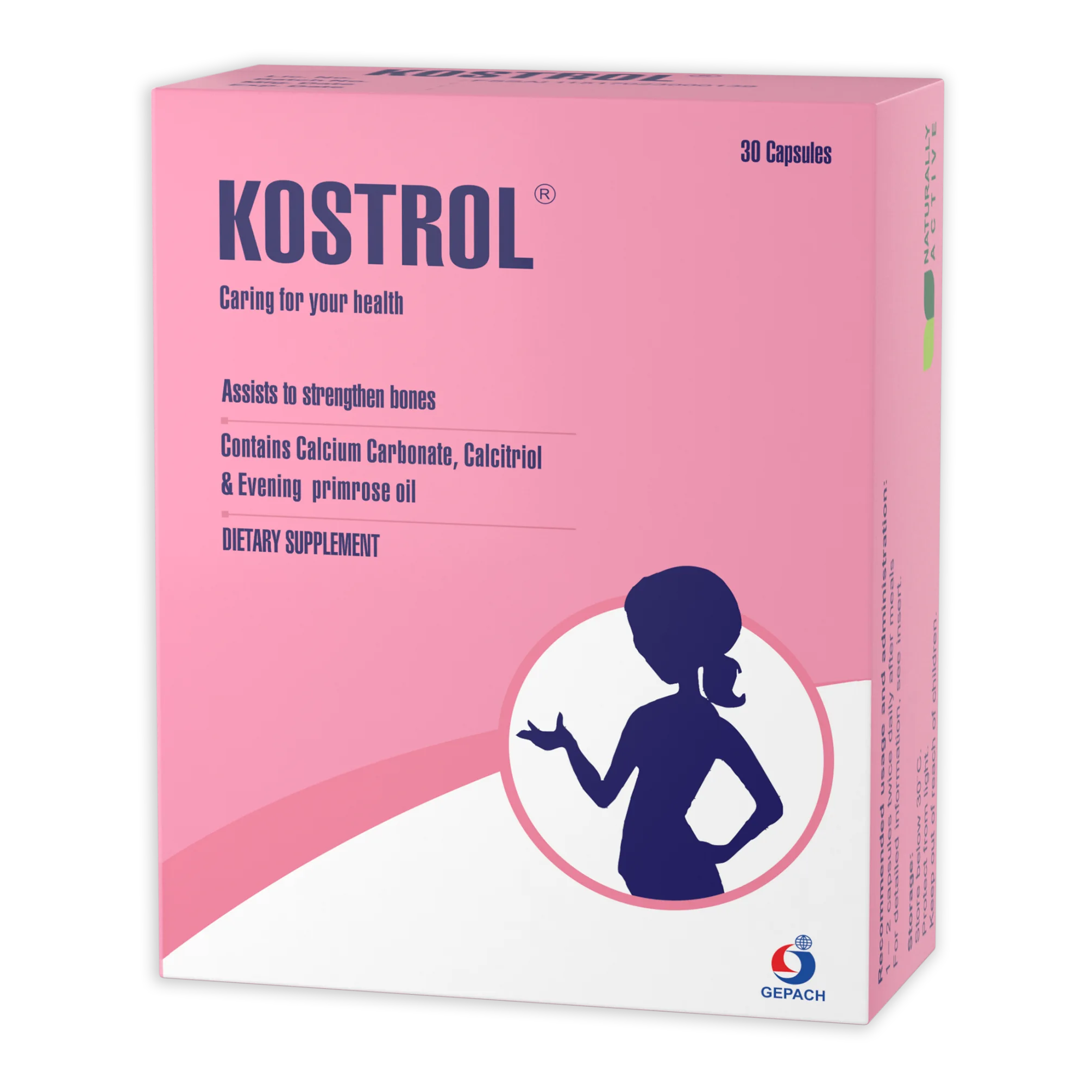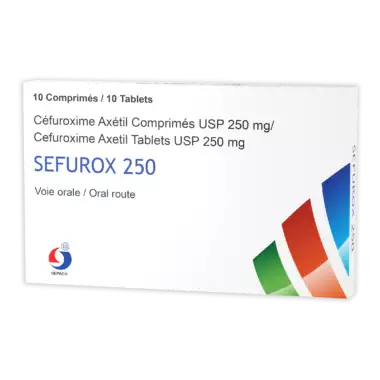Description
KOSTROL
Osteoporosis is a condition in which bones become less dense. This causes the bones to become excessively fragile and thus liable to fracture easily.
Kostrol Contains Elemental calcium (as calcium carbonate), Calcitriol and Evening primrose oil.
Composition
Each soft gelatin capsule of Kostrol contains:
- Elemental calcium………………625 mg(as calcium carbonate)
- Calcitriol………………………0.25 mcg
- Evening Primrose oil……………250 mg
Indications / Benefits
Kostrol is advocated for Osteoporosis, and especially in Peri- and Postmenopausal Osteoporotic women.
Pack sizes
10 softgel capsules in a blister strip. 3 blister strips in a pack.
FAQs
1) What is Osteoporosis?
Osteoporosis (OP) is a condition in which bones become less dense. This causes the bones to become excessively fragile and thus liable to fracture easily.
2) Describe a bone’s structure.
The bone has a hard-outer covering called cortex. Inside the compact bone is a spongy (also called cancellous) bone which has a dense meshwork of supporting beams (trabeculae). The interconnecting spaces enclosed by the trabeculae constitute the bone marrow.
3) What does the bone contain?
The bone has minerals within it for its strengthening. This mineral content is expressed as bone mineral density (BMD) – quantity of minerals (gm) in the measured surface area (cm2) of the bone (gm/cm2).
4) Which are the major minerals present in the bone?
Bone is mainly made up of calcium and phosphorous crystals embedded in a framework of interlocking protein fibers (collagen). The calcium (67% of bone content) is present as hydroxyapatite; the remaining 33% is collagen.
5) How does the calcium enter the bone?
Osteoclast cells facilitate the calcium removal, whilst osteoblast cells of bone help in fresh deposition of calcium. Deposited in the bones by special cells known as osteoblasts. This process is called remodeling, and it commences once the adulthood begins.
6) What happens in Osteoporosis?
In adult life, 250 -1000 mg of calcium is released by bones daily and the same quantum is put back by osteoblasts so that net bone loss / gain are nil. In this fashion, between 2-4% of the skeleton is dissolved and rebuilt back fully annually.
Between 3rd and 4th decades of life, the equilibrium in bone calcium loss / uptake shifts. This is because the removal by osteoclasts is not fully compensated by osteoblasts during remodeling in the elderly. Hence, OP is definite to commence during the 30s or 40s unless appropriate preventive intervention is resorted to.
7) Who are prone to Osteoporosis?
OP is a disease of the elderly (involutional osteoporosis). Involutional OP, further, can be type I when it occurs in postmenopausal women, or type II when it is age-related (men & women beyond 65 years). Rarely, children could suffer from OP (juvenile osteoporosis).
8) What are the causes of Osteoporosis?
The aging process itself (type II OP), and the hormonal (estrogen-progesterone) depletion in menopause (type I OP) are the main cause of OP. However, OP could occur due to many other reasons (secondary OP) such as include malnutrition, hormonal disturbances (parathyroid hormone excess / thyroid hormone deficiency), prolonged corticosteroid intake (as by those suffering from allergic asthma, rheumatism, etc) or bone diseases such as cancer.
9) How can we be aware of Osteoporosis?
Most often osteoporosis does not cause any symptoms. Only when it is moderate-to-severely progressed could there be various manifestations.
- Cramps in the legs at night.
- Neck pain, discomfort in the neck other than from injury.
- Persistent pain in the spine or muscles of the lower back
- Rib pain.
- Tooth loss.
- Brittle fingernails.
- Broken bones (fractures).
- Loss of height as a result of weakened spines in very severe OP. A person may find that his/her clothes are no longer fitting and their pants looking longer. Patients may lose as much as 6 inches in height.
- Spinal deformities (in severe OP) become evident like stooped posture, an outward curve at the top of the spine as a result of developing a vertebral collapse on the back.
10) Is there any test to detect Osteoporosis?
The most exact way to measure bone density is by a DEXA-scan (Dual-energy x-ray Absorptiometry) which is done on the whole body. A DEXA-scan takes about ten minutes and is associated with minimal radiation exposure.
A DEXA-scan report compares the patient’s BMD values with those of young normal patient (T score). A T score value >-1.
11) What is Osteopenia?
Osteopenia refers to DEXA-scan reported T scores between -1 and -2.5. This is the range reported in borderline OP; if appropriate intervention measures are instituted at this stage itself, OP could be prevented.
12) What is the best regimen to tackle Osteopenia?
Calcium supplements decrease the rate of bone loss in the elderly. Concomitant vitamin D is necessary to increase calcium absorption. Bisphosphonates (alendronate, etidronate, residronate, clodronate, tiludronate, pamidronate, ibandronate) are the latest in managing OP. They assist by re-establishing the normal balance between osteoblastic and osteoclastic activities. In postmenopausal OP, women are advised to supplement their waning estrogen levels.
13) Which is the best calcium salt to take?
The best calcium salt is that which provides highest blood levels so that its availability to bones is best. The most researched salts are calcium carbonate and calcium citrate from the view points of calcium content and calcium absorption in blood.
Calcium carbonate has an edge over calcium citrate in view of its higher elemental mineral content. Each 1 gm of calcium citrate salt provides 210 mg of elemental calcium; for calcium carbonate 1 gm this is 400 mg! No other calcium salt provides such high 40% elemental calcium content as calcium carbonate till date!
Besides the highest elemental calcium content calcium carbonate’s absorption has been proven to be as high as 39% by very sensitive analytical methods.1 This means that for every 1 gm of calcium carbonate taken, 400 mg elemental calcium enters the intestines, and nearly 160 mg of this finds it way into the blood!
Even the now available calcium citrate2 and calcium citrate malate3 are not absorbed to any great extent beyond 40%.
14) How can calcium absorption be enhanced further?
Vitamin D is traditionally known for its ability to facilitate calcium absorption. In the liver and kidneys, vitamin D3 (cholecalciferol) is stepwise converted to 25-hydroxycholecalciferol (calcifediol) and 1, 25 -dihydroxycholecalciferol (calcitriol) respectively.
Calcitriol enters the lining cells (enterocytes) of small intestine and stimulates special proteins (calbindins) which are needed for calcium uptake. Calcitriol enhances calcium absorption by as much as 34%, and this beneficial action occurs within 2-6 hours of its intake along with calcium carbonate.
15) Are there any other alternatives to Calcitriol?
Yes. Calcifediol is marketed as synthetic alfacalcidol. This also expedites calcium absorption, but the action of calcitriol is twice better in this regard!5 Another advantage of calcitriol is it will work inspite of disturbances in liver and kidney but alfacalcidol is dependent on kidneys to be converted to active calcitriol. Remember, it is ultimately calcitriol which matters and works.
16) Are there any other means to maximize calcium availability & utilization?
There are other natural adjuvants which could enhance calcium absorption besides calcitriol. One of these is Evening Primrose Oil (EPO) that is derived from the seeds of a biennial plant – Oenothera biennis or Oenothera lamarckiana. EPO contains an essential fatty acid called gamma linolenic acid (GLA) that has critical role to play in enhancing calcium absorption, decreasing calcium excretion by kidneys as well as facilitating calcium uptake by bones.
17) What are the benefits of Evening Primrose Oil (EPO)?
The nature of enterocyte’s covering membrane determines calcium’s absorption. The more fluidic its consistency, the better is the calcium movement from intestine to blood. GLA increases the fluidity of enterocytes’ membrane and this is the prime mechanism of its utility in increasing calcium levels in blood. By taking GLA bone calcium uptake has been demonstrated to be 2.7 times more as compared to those taking plain (sans GLA) calcium supplements!
In menopause, women lose 2-4% of their bone mineral each year. In addition there are additional complaints of hot flushes, mood swings, and sexual intercourse-related difficulties related to vaginal dryness. The special prostaglandin (PG) manufactured from GLA, namely PGE1 (instead of the normally available PGE2) helps in allaying all the menopausal complaints accompanying type I OP.
18) What could be the side-effects of Calcium, Calcitriol & EPO?
Besides, an insignificant stomach- / intestine–related disturbances, this blend of ingredients is not expected to cause any undue disturbances. However regular monitoring of blood calcium levels is recommended for those who take calcium or calcitriol on long term basis. Calcitriol containing products are not to be taken during pregnancy, or by those intending to conceive.
19) Who could ideally take Kostrol?
In Russia and Uzbekistan the estimated prevalence of OP is 10.3%.7 Besides, 40% of Russian women have osteopenia.8 In such cases Kostrol is ideal to prevent the osteopenia from progressing into OP, besides tackling the OP per se.
20) Can Kostrol reverse Osteoporosis?
Kostrol contains calcitriol which has been widely studied and proven for its anti-osteoporotic benefit. Besides, promoting calcium absorption, calcitriol also decreases excessive hormonal-mediated calcium loss (especially in menopause); calcitriol even conserves body’s calcium by diminishing its removal by the kidneys. Calcitriol main action lies in its ability to facilitate new calcium uptake by the osteoporotic bone.
21) How long can Kostrol be taken?
Kostrol can be taken as long as necessary to derive benefits from its ingredients. Only prolonged intake warrants checking of calcium levels in blood periodically such that they do not exceed the normal range of 9-11 mg/dl.




